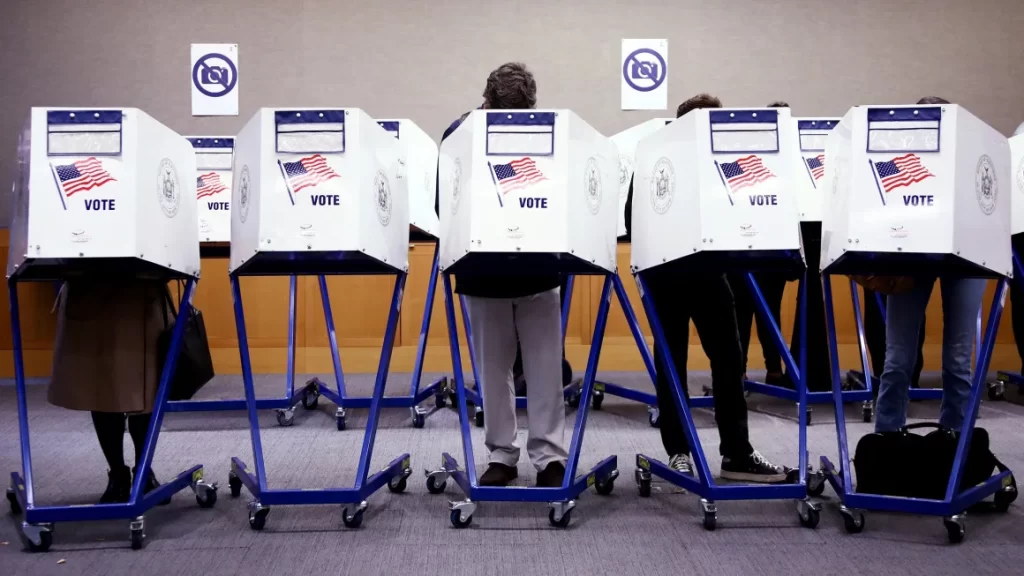Feds are still grappling with deluge of disinformation that targeted US election
4 min read
Voters fill out their ballots at a polling station in New York City on Election Day, November 5. Leonardo Munoz/AFP/Getty Images

Voters fill out their ballots at a polling station in New York City on Election Day, November 5. Leonardo Munoz/AFP/Getty Images
Federal authorities are still grappling with a series of bomb threats and disinformation campaigns linked to foreign adversaries, underscoring the ongoing battle to secure U.S. elections against online interference. As Election Day passed, the FBI and other agencies found themselves managing an overwhelming number of falsehoods, hoaxes, and threats aimed at disrupting the electoral process. These included bomb threats in swing states and a deluge of disinformation peddled by foreign actors.
In the days leading up to, during, and after the election, U.S. intelligence agencies worked overtime, tracking disinformation and monitoring social media platforms. Several sources familiar with the operations revealed that Russian operatives were behind a significant portion of these online efforts, marking the most proactive response from the government against foreign interference to date. This effort reflects a marked shift from previous elections, especially with the rise of social media as a tool for influencing public opinion.
Russian and Foreign Involvement in Election Threats
The bomb threats sent to multiple polling centers on Election Day were traced to email addresses linked to Russian domains, though the exact origins and perpetrators remain unclear. Authorities quickly moved to investigate these threats, which led to temporary evacuations at some polling places and added unnecessary tension in an already fraught election environment. While it’s not yet determined whether the threats affected voter turnout, it is clear that this new method of intimidation had the potential to sow chaos.
The U.S. intelligence community has identified a broader pattern of disinformation originating from several countries, including Russia, China, and Iran, who have actively worked to undermine the election process. According to Jen Easterly, head of the U.S. Cybersecurity and Infrastructure Security Agency (CISA), the 2024 election saw an “unprecedented amount of disinformation” spread by foreign adversaries, with falsehoods being aggressively promoted on a scale never seen before.
The FBI, CISA, and other federal agencies have been scrambling to debunk viral false content as quickly as possible. This has been a rapid, coordinated effort across federal and independent platforms, a stark contrast to the slower response of previous election cycles. Emerson Brooking of the Atlantic Council’s Digital Forensic Research Lab called it “the fight against foreign interference moved at light speed,” with fake videos and images quickly traced back to Russian operatives and other foreign sources.
Online Hoaxes, Threats, and Cybersecurity
While disinformation campaigns were rampant, it wasn’t just fake news that caused concern. Federal authorities also saw attempts to hack into election offices and swatting incidents—hoax calls designed to trigger large law enforcement responses. Cybersecurity experts noted that despite these efforts, the overall election infrastructure withstood the threats, although it’s clear that the risk of online disruption remains a serious concern.
One of the most notable new tactics emerged on Election Day: bomb threats sent to several battleground states, including Arizona, Georgia, and Pennsylvania. While it’s unclear if these threats disrupted voting, they represent a new level of coordination in foreign efforts to undermine the electoral process. One email address involved in the bomb threats was reportedly linked to a string of similar hoaxes targeting LGBTQ+ events earlier in the year. For example, an email address connected to a threat during the Pride Event in Minnesota in June was also tied to the threats on Election Day, suggesting that these bomb threats may be part of a larger, ongoing disinformation and intimidation campaign.
The Bigger Picture of Global Disruption
Investigations into the bomb threats have revealed that Russian-linked email addresses are not just part of a one-off hoax campaign, but rather a broader, multi-year effort involving false bomb threats at schools, universities, and airports across the world. This far-reaching campaign suggests that the election bomb threats were not an isolated incident but a continuation of a long-running operation aimed at creating chaos on the global stage.
Cybersecurity firm Graphika, which tracks online disinformation, confirmed that the email addresses involved in the Election Day threats have been linked to numerous bomb hoaxes around the world since at least 2022. The company’s chief intelligence officer, Jack Stubbs, suggested that this was a part of a much larger pattern, with fake bomb threats being sent to various institutions in the U.S. and abroad.
The Ongoing Fight Against Foreign Influence
The disinformation and threat campaigns highlight the ongoing challenges facing U.S. intelligence and law enforcement agencies. As foreign adversaries continue to target the U.S. electoral system, the need for vigilance and swift action becomes even more apparent. With the rise of social media, foreign actors have found new avenues to spread false information and incite chaos.
As the investigation continues, federal authorities are committed to ensuring the integrity of the election process and combating the spread of misinformation. While the threats from foreign adversaries may not have fully impacted the outcome of the election, their ability to sow discord among voters and disrupt the process remains a serious concern for future elections. As we move forward, U.S. agencies will need to adapt quickly to these evolving threats to protect democracy from foreign influence.